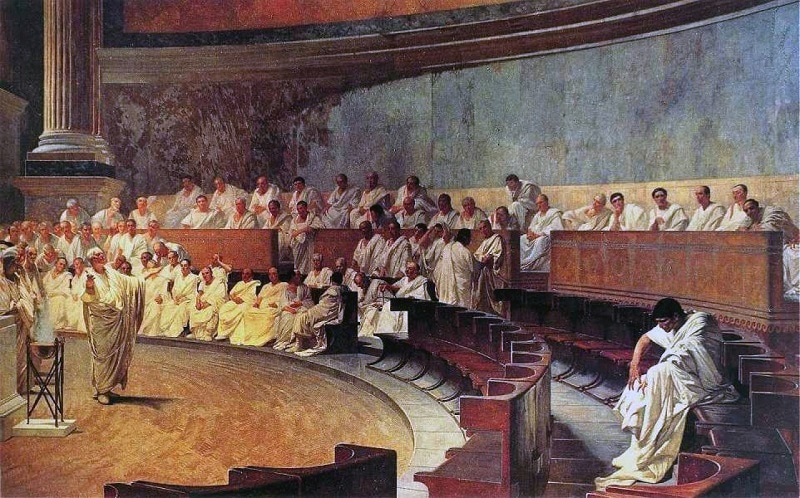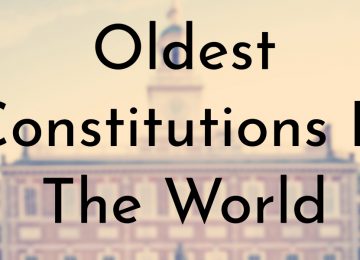Like many facets of modern life, the first forms of government emerged when the very first civilizations began to form. These early governments were not much different from today’s governments as they oversaw the economy, trade, healthcare, education, taxes, urban planning, and the building of public works such as roads and canals. These practices have survived for thousands of years and are still implemented by governments around the globe.
7. Japan
Year Established and Ended: c.660 BCE – today
Current Form of Government: Unitary Parliamentary Constitutional Monarchy
Current Constitution Date: May 3, 1947
 photo source: Wikimedia Commons
photo source: Wikimedia Commons
Japan considers 660 BCE to be the year that the country was founded because it was the year that Emperor Jimmu, the first Emperor of Japan, ascended the throne. According to legend, Emperor Jimmu was a descendant of the sun goddess Amaterasu and every emperor since then can trace their lineage back to Jimmu. While this is what the Japanese believe, Emperor Jimmu and a majority of Japan’s earliest emperors are considered legendary and no one knows for sure whether or not they existed.
Despite the uncertainty over the existence of Japan’s first emperors, Japan was a monarchy for much of its history and today it is one of the few remaining constitutional monarchies in the world. Although Japan has always been ruled by an Emperor, during several periods the Emperor was only a figurehead.
During one of the longest periods of Japanese history(1185 – 1868), the country was ruled by a shōgun who used military power to establish control over large territories. After the Meiji Restoration in 1868, Japan returned to a Imperial rule and the Meiji Constitution was established in 1889, resulting in the first parliamentary system in Asia.
6. Ancient Rome
Year Established and Ended: c.753 BCE – 1453 CE
Current Form of Government: Modern-day Italy – Unitary Parliamentary Constitutional Repulic
Current Constitution Date: June 2, 1946
 photo source: Wikimedia Commons
photo source: Wikimedia Commons
Along with the ancient Greeks, the ancient Romans made several contributions to modern government, law, and politics. According to Roman mythology, Rome was founded on April 21, 753 BCE by Romulus and Remus, who were descended from the Trojan prince Aeneas.
During the first period of ancient Roman history, the civilization was ruled by a monarchy, which was eventually overthrown around 509 BCE. Rome became a republic and its government was controlled by patricians, a wealthy, landowning minority who traced their ancestry to Rome’s foundation. Under the Roman Republic, social class and wealth determined a citizen’s voting rights, this led to a power imbalance between the ruling class and the plebs (common people).
The Roman Republic ended in 27 BCE as the Roman Empire began to rise and dominated not only the Italian peninsula but territories in other parts of Europe, Africa, and Asia. Imperial Rome established three major branches of rule: the central government, the military, and provincial government.
After the fall of the Roman Empire, Italy had many wars and was ruled by monarchs and a fascist regime before becoming a modern republic.
5. Ancient Greece
Year Established and Ended: c.1100 BCE – c.600 CE
Current Form of Government: Unitary Parliamentary Republic
Current Constitution Date: June 11, 1975
 photo source: Wikimedia Commons
photo source: Wikimedia Commons
The government of ancient Greece, particularly from the Classical period (c.500 – c.323 BCE), is considered one of the most influential in modern history. As everyone already knows, the Greeks were responsible for establishing democracy, which is a form of government used by much of the world today.
Before democracy was developed in Classical Athens, ancient Greece was divided into city-states. By the Archaic Period (c.8th century – c.480 BCE) these city-states became aristocratic oligarchies. As politics began to dominate life in Greece, many cities ended up begin ruled by a tyrant (different from the modern version) who would govern according to their own will. Eventually, democracy gained in popularity and nearly every city-state established their own democracies.
4. China
Year Established and Ended: c.2070 BCE – present
Current Form of Government: Unitary One-Party Socialist Republic
Current Constitution Date: December 4, 1982
 photo source: Wikimedia Commons
photo source: Wikimedia Commons
Like Japan, the history of China’s very first dynasty (Xia dynasty c.2070 – c.1600 BCE) is considered apocryphal and although its existence is widely believed by the Chinese it may not be historically accurate. After the Xia dynasty, a few more dynasties rose in ancient China before the Imperial period began in 221 BCE.
The Qin dynasty is considered to be China’s first Imperial dynasty and Qin Shi Huang was the first Emperor. China continued under Imperial rule until the end of the Qing dynasty in 1912. After this, the Republic of China was established and Sun Yat-sen briefly served as the Republic’s first President.
The Republic of China only lasted for a few decades until the Communist Party of China won the Chinese Civil War in 1949. Communist Party Chairman Mao Zedong declared that the country was now the People’s Republic of China (PRC), which still remains as China’s official title.
3. Ancient Egypt
Year Established and Ended: c.3050 BCE – 641 CE
Current Form of Government: Unitary Semi-Presidential Rebublic
Current Constitution Date: January 18, 2014
 photo source: Wikimedia Commons
photo source: Wikimedia Commons
The ancient Egyptians have the most well-known and thoroughly documented government out of all the first civilizations. Through the records that the ancient Egyptians kept we know that every aspect of Egyptian life was organized and ruled over the different levels of government.
At the top of the government’s hierarchy was the pharaoh who, in theory, had complete control over ancient Egypt’s land, resources, and people. After the pharaoh was the king, who was the military commander, and then there was vizier who had the most duties. The vizier acted as the king’s representative and coordinated land surveys, the treasury, building projects, the legal system, and the archives. The country was further divided into nomes, which were ruled at the regional level by a nomarch.
2. Harappan Civilization (Indus Valley)
Year Established and Ended: c.3300 – c.1300 BCE
Current Form of Government: None – spread across what is now several different countries
Current Constitution Date: None
 photo source: Wikimedia Commons
photo source: Wikimedia Commons
Not much is known about the Harappan Civilization’s government but archaeological evidence suggests that they did have some some kind of central leadership. The Harappans were known for their well thought out urban planning as all of the cities uncovered had the same layout — this would have required a central government.
The economy of the Indus Valley relied heavily on trade and many people believe that the Harappans were the first civilization to use wheeled transport to facilitate their trade network. Additionally, Harappan artifacts — such as pottery, seals, weights, and bricks — were designed uniformly. All of these features of Harappan life were most likely planned by a central authority.
1. Sumer (Ancient Mesopotamia)
Year Established and Ended: c.4500 – c.1900 BCE
Current Form of Government: Modern-day Iraq – Federal Parliamentary Republic
Current Constitution Date: October 15, 2005
 photo source: Wikimedia Commons
photo source: Wikimedia Commons
As one of the first urban civilizations in the world, the Sumerians established the world’s first and oldest government. By the 4th millennium BCE, Sumer was divided into many city-states which were ruled by a priestly governor or king. The Sumerians are also responsible for the oldest known law code found today, the Code of Ur-Nammu.
The Sumerian government ran several public programs including the use of an agricultural specialized labor force and a massive irrigation and canal system. All Sumerians, excluding the rich, were required by the government to work on the canals in a corvee (intermittent, unpaid labor). Although the Sumerian civilization no longer exists, their descendants are the modern-day people of Iraq.
”OTHER











